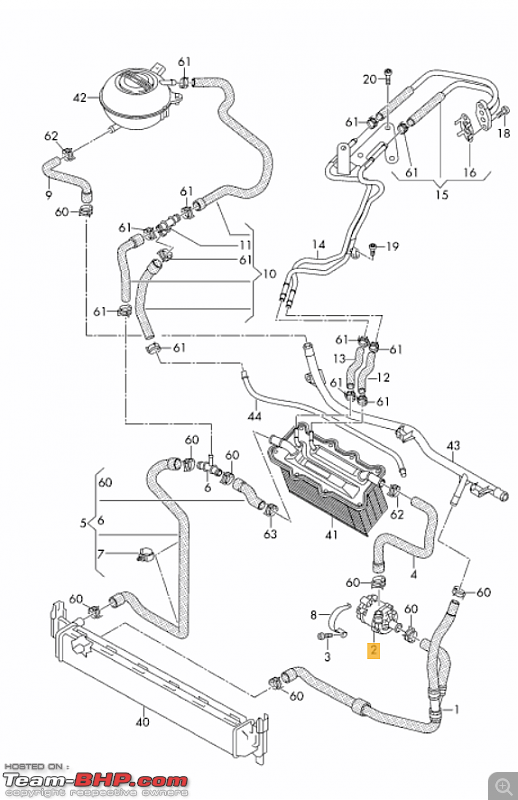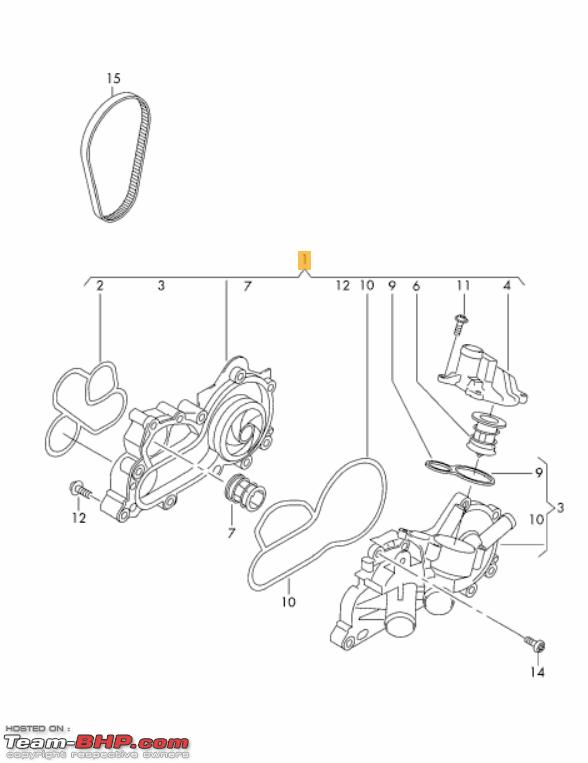Quote:
Originally Posted by akshay4587  Bubbling or Boiling coolant is not normal at all.
It's a sign of air in system, however this definitely is strange in a brand new car.
I had this issue in one of my cars after hose replacement, and repeated bleeding of system fixed the issue.
If it was my car, I would chase VW till they fix this. |
Yes, that was my precisely
my first reaction during my first ever experience with this engine when I drove it in July, and yes, this agreeable has been a common symptom depicting air in the cooling system, but presently, I really wouldn't be too concerned
since it is a brand new vehicle, with a
5 year warranty, and looking for faults in it, when it is meant to be driven a day at a time, would only distort the peace of mind one purchases it for, and if you've been following my ownership thread, I just got my car back after a
windshield repair which took 3 weeks and so I'm really not mentally in a position to chase Volkswagen at present, since the vehicle is
not having any heating issues.
On another note, I just completed my
Swagat Service and did highlight this issue to them and we witnessed the
same phenomena on every other 1.0 TSI engine which was in the workshop for a similar service. The service guys were
surprisingly not concerned by this issue, and asked me to enjoy the vehicle.
Quote:
Originally Posted by ChoosetoCruze  Iíve yet to see this phenomenon happen in a NA engine.
I see, well in that case, that tiny turbocharged engine is being worked like mad to extreme temperatures & pressures (typical for small turbo engines). As a result, because the water pump stops pumping the coolant which stops circulating completely, the engine block is still very hot due to the coolant circulation stops, the cooling fan stops too, the heat continues to build up causing the coolant to overflow to the reservoir.
Which brings me to my next question, is the coolant in the expansion tank above the maximum mark even after the engine is cold? This should be an easy check, first thing in the morning - on a level surface, with a cold engine, the coolant should be at or below the maximum mark.
If VW have indeed designed this to be normal, they have further strengthened my belief that they are designing engines to have a limited shelf life thanks to these ruthless engine operating conditions. |
Yes. I have not noticed this in any other NA engine we have had (1.2L Kappa and 1.2L K12M), but both of those engines had a separate radiator cap and a coolant reservoir, thus making it a slightly unfair comparison. Most of the VAG cars we have (Jetta, Tiguan, Polo) and even other VAG cars for that matter
do not have a separate pressurised Radiator Coolant Cap making me believe the cooling system could be designed differently.

As prompted, I have attached a photo of the Coolant Tank taken this morning and I still maintain that
I have found the Coolant to be Overfilled (COLD Engine) above the MAX mark right from the time the vehicle was driven out of the trailer, making me affirm that the Coolant was Overfilled at the plant itself. What beats me and
makes me wonder is
WHY Volkswagen is overfilling their Coolant systems because I have genuinely documented a consistently high number of new vehicles with this phenomena.
The very first time I saw this bubbling was after a 50km spirited drive and that gave me the same impression you had - ' The struggle this 1.0 EA211 downsized engine was having with all the equivalent power from the 1.2L making me worry about it. But that being said, Volkswagen has already rolled out 25,00,000+ EA211 engines (as of 2019) and considering those high volumes, I really hope they have gotten their math and research right.

On another note would like to
highlight another specific instance which is a little off-topic but pertains to the TDI engine. You can Google or YouTube Search "
TDI Blowby" to find videos of relatively new Diesel engines with dancing, vibrating Oil Filler Caps and smoke emerging from the dipstick. Quite a number of viewers were quick to diagnose this as an Engine Compression issue and even local mechanics said "Engine will need to be overhauled." I'm happy to report that Compression tests on most such engines were hardly negative and the very same TDI engines lived on and are
still doing duty even after 3,00,000kms without the need for an overhaul.
I wanted to mention this as my friend's
Rapid 1.6 TDI exhibited this blowby and engine smoke from the Oil Filler Cap at 45000kms or so and today, it is still going strong at 2.5L kms out of which 1.5L kms have been kilometres put in after a Stage 2+ Remap.

So I'd take events documented on the internet with a pinch of salt, since
they could just not be relevant to every vehicle.
My Plan Of Action- Siphoning out some extra coolant.
- Obtaining a DSHA Engine Service Manual.
- Performing Air Bleeding by the method suggested.
- Updating the post and thread after the rectification.
- Seeking clarification from Volkswagen.

Will update some more information after corrective actions, observations and researching more about the construction of this engine which I believe has two water pumps. One integrated in the
Thermostat Housing and the other one
04L 965 567 A near the charge air cooler, since they have two unique different part numbers.

 (2)
Thanks
(2)
Thanks
 (2)
Thanks
(2)
Thanks
 (5)
Thanks
(5)
Thanks
 (8)
Thanks
(8)
Thanks
 (3)
Thanks
(3)
Thanks
 (3)
Thanks
(3)
Thanks
 (1)
Thanks
(1)
Thanks
 (2)
Thanks
(2)
Thanks
 (2)
Thanks
(2)
Thanks
 (1)
Thanks
(1)
Thanks





 . (I highly doubt so.)
. (I highly doubt so.)



 my apologies. I replied to the thread asking a fellow users if he noticed the gurgling and coolant bubbling and even shared that I noticed it bubbles after a drive. Diving more into the details through a study of the EA 211 Self Study Guide gave me some more insight about the cooling system, but the general consensus about bubbling let to a scare that made me consider the many possible explanations to the phenomena which was novel to me as well. Yes, I do make it a point to read every car manual till I know everything it has to offer and even though the Polo is a less-complicated product, I did go through the manual entirely.
my apologies. I replied to the thread asking a fellow users if he noticed the gurgling and coolant bubbling and even shared that I noticed it bubbles after a drive. Diving more into the details through a study of the EA 211 Self Study Guide gave me some more insight about the cooling system, but the general consensus about bubbling let to a scare that made me consider the many possible explanations to the phenomena which was novel to me as well. Yes, I do make it a point to read every car manual till I know everything it has to offer and even though the Polo is a less-complicated product, I did go through the manual entirely.